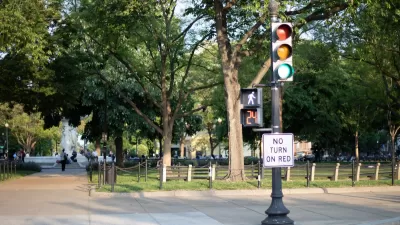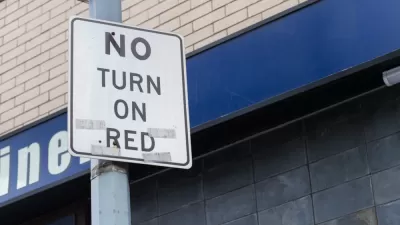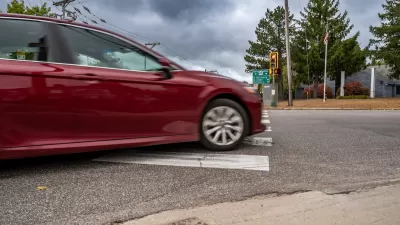Every new traffic light in the city will be required to install ‘No Turn on Red’ signs, a tactic shown to reduce collisions.

All newly installed or repaired traffic signals in Seattle will bar drivers from turning right on red. As Ryan Packer points out in The Urbanist, “The change doesn’t mean that right-on-red will be restricted every single intersection in Seattle anytime soon, but rather that every time a project within the department deals with replacing or modifying a traffic signal, SDOT will have to find a reason justifying not to add ‘no turn on red’ signage.” Allowing cars to turn right on red will now require a “significant operational reason.”
In Washington, D.C., banning right turns on red resulted in a 97 percent reduction in driver-to-driver conflicts and a 92 percent reduction in vehicle-pedestrian conflicts. According to a study published in the Institute of Traffic Engineers (ITE) journal, “These improvements came at overall minor impacts to traffic operations. These findings have helped the District identify a low-cost safety tool that will help in its pursuit of Vision Zero.”
Packer adds that “The new policy will not apply when the city does routine maintenance, or when it modifies signals to add Accessible Pedestrian Signals (APS), which provide low-vision people auditory clues that it’s safe to cross the street. The rule will also not apply when signal timing is the only thing about a signal that is modified.”
SDOT expects roughly 150 intersections will have restricted turns on red by the end of this year, “still just a fraction of the over 1,000 signalized intersections that SDOT maintains citywide.”
FULL STORY: No Right Turn on Red Is Now the Default in Seattle

Alabama: Trump Terminates Settlements for Black Communities Harmed By Raw Sewage
Trump deemed the landmark civil rights agreement “illegal DEI and environmental justice policy.”

Planetizen Federal Action Tracker
A weekly monitor of how Trump’s orders and actions are impacting planners and planning in America.

The 120 Year Old Tiny Home Villages That Sheltered San Francisco’s Earthquake Refugees
More than a century ago, San Francisco mobilized to house thousands of residents displaced by the 1906 earthquake. Could their strategy offer a model for the present?

LA’s Tree Emergency Goes Beyond Vandalism
After a vandal destroyed dozens of downtown LA trees, Mayor Karen Bass vowed to replace them. Days later, she slashed the city’s tree budget.

Sacramento Leads Nation With Bus-Mounted Bike Lane Enforcement Cameras
The city is the first to use its bus-mounted traffic enforcement system to cite drivers who park or drive in bike lanes.

Seattle Voters Approve Social Housing Referendum
Voters approved a corporate tax to fund the city’s housing authority despite an opposition campaign funded by Amazon and Microsoft.
Urban Design for Planners 1: Software Tools
This six-course series explores essential urban design concepts using open source software and equips planners with the tools they need to participate fully in the urban design process.
Planning for Universal Design
Learn the tools for implementing Universal Design in planning regulations.
Ada County Highway District
Clanton & Associates, Inc.
Jessamine County Fiscal Court
Institute for Housing and Urban Development Studies (IHS)
City of Grandview
Harvard GSD Executive Education
Toledo-Lucas County Plan Commissions
Salt Lake City
NYU Wagner Graduate School of Public Service





























